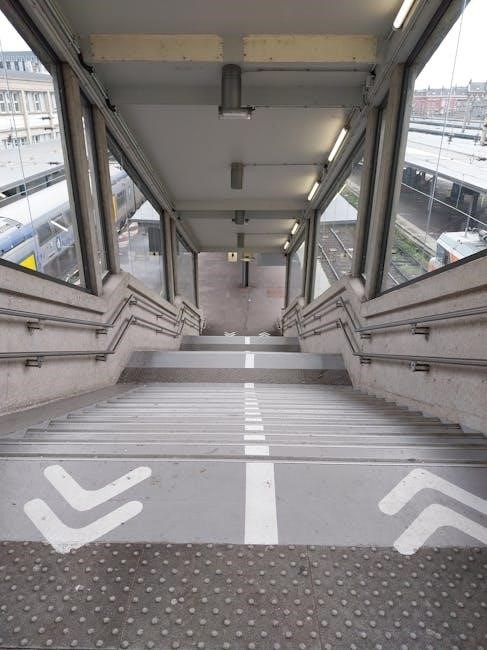Elevator guide rails are essential components ensuring smooth and safe vertical movement. Typically made of steel, they guide the cabin along the hoistway, crucial for stability and alignment.
1.1 Definition and Purpose
Elevator guide rails are steel components installed along the hoistway walls to ensure the elevator cabin moves smoothly and stays aligned. Their primary purpose is to provide structural support and guidance, preventing the cabin from deviating from its path. These rails are crucial for maintaining stability, reducing wear on elevator components, and ensuring safe operation. They work in conjunction with guide shoes attached to the elevator car, creating a reliable system for vertical transportation in various buildings.
1.2 Importance in Elevator Systems
Elevator guide rails are critical for ensuring smooth, safe, and efficient operation. They provide alignment and stability to the elevator car, preventing uneven movement and potential collisions. By guiding the car along the hoistway, these rails reduce mechanical stress and wear on other components. Their role is vital for maintaining passenger safety, minimizing maintenance needs, and ensuring reliable performance in high-traffic environments. Without guide rails, elevators would lack the precision and stability required for modern transportation demands.

Types of Elevator Guide Rails
Elevator guide rails come in various designs, including T-rails, round rails, and flat guide rails, each offering unique benefits for different elevator systems and applications.
2.1 T-Rails
T-rails are a common type of elevator guide rail, typically made of steel, designed to guide the elevator cabin along the hoistway. Their distinctive “T” shape provides structural stability and alignment, ensuring smooth movement. Widely used in various elevator systems, T-rails are known for their durability and compatibility with both passenger and freight elevators, making them a reliable choice for diverse applications.
2.2 Round Rails
Round rails are another popular type of elevator guide rail, known for their circular cross-section. Typically made of steel or stainless steel, they are durable and resistant to wear. Their smooth surface allows for quiet operation, reducing friction and noise. Round rails are often used in panoramic elevators, where aesthetics are important, and provide excellent guidance for the elevator cabin. Their design ensures efficient and safe movement, making them a preferred choice for specialized and high-end elevator systems.
2.3 Flat Guide Rails
Flat guide rails are characterized by their rectangular shape, offering a stable and rigid structure for elevator systems. Made from robust materials like steel, they provide excellent strength and durability. These rails are commonly used in high-capacity elevators, such as freight and industrial lifts, where heavy loads are involved. Their flat design allows for precise alignment and minimal vibration, ensuring smooth operation. Additionally, flat guide rails are often preferred for their cost-effectiveness and ease of installation, making them a practical choice for various elevator applications.
Materials Used for Guide Rails

Guide rails are commonly made from durable materials like steel and stainless steel, offering strength, corrosion resistance, and reliability for smooth elevator operations and long-term durability.
3.1 Steel Rails
Steel rails are commonly used in elevator systems due to their strength and durability. They provide structural support and ensure smooth movement of the elevator cabin.
Steel rails are typically installed along the hoistway walls, guiding the elevator car along its travel path. Their robust construction minimizes wear and tear, making them a reliable choice for both passenger and freight elevators.
Regular maintenance is essential to extend their lifespan and ensure optimal performance.
3.2 Stainless Steel Rails
Steel rails are commonly used in elevator systems due to their strength and durability. They provide structural support and ensure smooth movement of the elevator cabin.
Steel rails are typically installed along the hoistway walls, guiding the elevator car along its travel path. Their robust construction minimizes wear and tear, making them a reliable choice for both passenger and freight elevators.
Regular maintenance is essential to extend their lifespan and ensure optimal performance.
3.3 Other Materials
Beyond steel, other materials like aluminum, titanium, and fiber-reinforced polymers are used for elevator guide rails. These alternatives offer unique benefits, such as corrosion resistance, lightweight construction, and reduced maintenance. Aluminum rails are ideal for lightweight applications, while titanium provides exceptional strength-to-weight ratios. Fiber-reinforced polymers are durable and resistant to environmental factors, making them suitable for outdoor or high-humidity environments. These materials enhance performance and longevity in specialized elevator systems, catering to specific architectural or functional requirements.

Installation of Elevator Guide Rails
Proper alignment and secure fixation are critical for installing guide rails. Ensure rails are level, firmly anchored, and tested post-installation to guarantee smooth elevator operation and safety.
4.1 Preparation and Alignment
Preparation involves cleaning the hoistway and ensuring the walls are level. Proper alignment of guide rails is critical, using tools like lasers or levels. Misalignment can cause operational issues or safety hazards.
4.2 Fixation and Fastening
Fixation and fastening involve securing guide rails to the hoistway walls using brackets and bolts. Proper tightening ensures stability and alignment, preventing movement during operation. Brackets are typically spaced evenly, and bolts are tightened sequentially to avoid misalignment. Special tools may be used for precise torque settings. This step is critical for ensuring the elevator’s smooth operation and safety, as loose or improperly secured rails can lead to malfunctions or accidents. Regular checks are recommended to maintain optimal performance.
4.3 Testing Post-Installation
Post-installation testing ensures guide rails function correctly. A visual inspection checks alignment and securement. Load tests simulate elevator operation to verify stability and smooth movement. Laser alignment tools may be used for precision. Any detected issues are addressed promptly to prevent future malfunctions. Proper testing guarantees the elevator’s safe operation and longevity, ensuring compliance with safety standards and regulations. This step is crucial for maintaining reliability and performance over time.

Maintenance and Repair
Elevator guide rails require regular maintenance to ensure optimal performance. This includes inspections, lubrication, and timely replacement of worn or damaged components to prevent operational issues.
5.1 Regular Inspection
Regular inspection of elevator guide rails is crucial for identifying wear, misalignment, or corrosion. Technicians use specialized tools to measure rail integrity and ensure proper alignment. Visual checks for signs of damage or excessive wear are standard. Lubrication levels and fastening components are also assessed. Any irregularities are documented for corrective action. These inspections help prevent unexpected failures, ensuring safe and efficient elevator operation. Compliance with safety standards is maintained through systematic evaluation and timely interventions.
5.2 Lubrication and Cleaning
Lubrication and cleaning of elevator guide rails are vital for maintaining smooth operation. Lubricants reduce friction between rails and elevator components, preventing wear and tear. Cleaning removes dirt, grease, and debris that can impair function. Regular lubrication schedules and the use of high-quality, compatible lubricants are recommended. Proper cleaning involves gentle yet effective methods to avoid damaging the rails. These practices ensure optimal performance, reduce maintenance costs, and extend the lifespan of the guide rails, contributing to overall elevator reliability and safety.
5.3 Replacement of Damaged Rails
Replacement of damaged elevator guide rails is critical for ensuring safety and performance. Inspect rails regularly for wear, corrosion, or misalignment. When damage is detected, disconnect power and use specialized tools to remove the faulty section. Install new rails with precise alignment to maintain smooth elevator movement. Proper torque and securing methods are essential. Replacement should only be performed by trained professionals to avoid further damage or safety risks, ensuring reliable operation and passenger safety.

Safety Features and Standards
Safety features like emergency braking systems and guide rail alignment ensure elevator stability. Compliance with elevator codes is mandatory for safe operation and passenger protection.
6.1 Safety Gear and Braking Systems
Safety gear and braking systems are critical for preventing accidents. These systems engage if the elevator exceeds safe speeds, halting the cab securely. Modern elevators use advanced braking mechanisms, often integrated with guide rails, to ensure stability. Guide rails are designed to work with safety gears, providing a failsafe mechanism. Regular inspections and compliance with elevator codes are essential to maintain reliability. These systems protect passengers and ensure smooth operation, even in emergencies.
6.2 Compliance with Elevator Codes
Compliance with elevator codes is mandatory for ensuring safety and functionality. Guide rails must meet specific standards regulating material quality, dimensions, and installation. These codes vary by region but universally prioritize passenger safety. Non-compliance can lead to legal penalties and operational risks. Regular inspections ensure adherence to these standards, while certifications guarantee reliability. Elevators must also comply with accessibility norms, ensuring equal access for all users. Proper compliance minimizes hazards and extends the lifespan of elevator systems.

6.3 Emergency Stop Mechanisms
Emergency stop mechanisms are critical safety features integrated into elevator systems. These mechanisms, often linked to guide rails, ensure the elevator can halt safely in emergencies; Activation triggers a braking system, securing the cabin in place. Compliance with safety codes ensures these systems are reliable and effective. Regular maintenance is vital to guarantee functionality, protecting passengers from potential hazards. These mechanisms are essential for preventing accidents and ensuring smooth, secure operation during unforeseen events. Their integration with guide rails enhances overall elevator safety and reliability.

Applications in Different Elevator Types
Elevator guide rails are used in passenger elevators for smooth operation, in freight elevators for heavy-duty loads, and in specialized elevators like panoramic ones for unique designs.
7.1 Passenger Elevators
In passenger elevators, guide rails ensure smooth and quiet operation, enhancing rider comfort. They are typically made of durable materials like steel or stainless steel, designed to withstand frequent use. Round rails are often used for panoramic elevators, providing a sleek appearance while maintaining functionality. These rails are crucial for alignment and stability, allowing the elevator to move seamlessly between floors. Proper installation and maintenance are essential to ensure safety and efficiency in high-traffic environments.
7.2 Freight Elevators
Freight elevators require robust guide rails to handle heavy loads and large cargo. T-rails are commonly used due to their strength and ability to support substantial weight. These rails ensure proper alignment and stability, crucial for moving heavy items without causing damage. Designed for durability, they withstand the rigors of industrial environments, ensuring reliable performance and preventing operational issues. Proper maintenance is essential to sustain their functionality in demanding conditions.
7.3 Specialized Elevators
Specialized elevators, such as panoramic or high-speed models, utilize guide rails tailored to their unique requirements. Round rails are often chosen for panoramic elevators to enhance visual aesthetics while maintaining smooth operation. These systems require precise alignment and advanced materials to ensure safety and performance. Custom designs cater to specific needs, such as energy efficiency or noise reduction, making them ideal for niche applications. Proper installation and maintenance are critical to uphold their specialized functions and longevity.

Technological Advancements
Modern guide rail systems incorporate advanced materials and smart technologies, reducing wear and enhancing efficiency. Innovations like energy-saving designs and predictive maintenance optimize performance and longevity in elevator systems.
8.1 Modern Materials and Designs
Modern elevator guide rails utilize advanced materials like high-strength steel alloys and lightweight composites, enhancing durability and reducing wear. Innovative designs, such as streamlined shapes, minimize friction and noise. These improvements ensure smoother operation and extended lifespan. Additionally, new manufacturing techniques enable precise alignment and installation, contributing to overall system efficiency and reliability. Such advancements not only meet current demands but also anticipate future needs in elevator technology.
8.2 Smart Guide Rail Systems
Smart guide rail systems integrate advanced sensors and IoT technology to monitor wear, alignment, and vibration in real time. These systems predict maintenance needs, reducing unplanned downtime. By analyzing data, they optimize performance and safety. Smart rails also adapt to building conditions, ensuring smooth operation. This technology enhances efficiency, extends lifespan, and improves user experience, making elevators more reliable and future-ready.
8.3 Energy Efficiency Improvements
Modern elevator guide rail systems incorporate energy-efficient designs, such as optimized rail profiles and low-friction materials, to reduce power consumption. Advanced lubrication systems minimize energy loss due to friction. Additionally, smart systems adjust rail alignment dynamically, ensuring smooth operation with minimal energy use. These improvements not only lower operational costs but also contribute to sustainability by reducing overall energy demand in buildings.

Environmental and Accessibility Considerations
Elevator guide rails are designed with environmental and accessibility in mind, focusing on noise reduction, energy efficiency, and compliance with accessibility standards for all users.
9.1 Noise Reduction Features
Elevator guide rails incorporate noise reduction features to minimize operational sound. Sound-dampening materials and sleek designs reduce vibrations, ensuring quieter movement. Lubrication and advanced coatings further lessen friction, enhancing noise reduction. These features improve passenger comfort and comply with noise regulations, making elevators suitable for various environments, including residential and commercial spaces. Modern guide rails prioritize both functionality and noise mitigation, contributing to a smoother and quieter elevator experience.
9.2 Accessibility Compliance
Elevator guide rails play a role in accessibility compliance by ensuring smooth, obstacle-free movement for all users. Tactile markings and Braille on buttons enhance usability for visually impaired individuals. The steady guidance provided by rails supports passengers with mobility challenges, while wide door openings and low thresholds facilitate easy access for wheelchairs. These features ensure elevators meet accessibility standards, promoting inclusivity and equal access for everyone, including those with disabilities.
9.3 Environmental Impact
Elevator guide rails contribute to environmental sustainability through material efficiency and energy-saving designs. Modern rails are often made from recycled steel, reducing resource depletion. Energy-efficient systems minimize power consumption, lowering carbon footprints. Additionally, quieter operations reduce noise pollution, creating a more eco-friendly environment. Sustainable manufacturing processes and durable materials further enhance their environmental benefits, ensuring longevity and reducing waste. These factors make guide rails a critical component in eco-conscious elevator systems.

